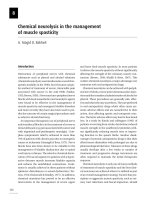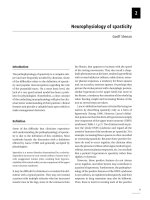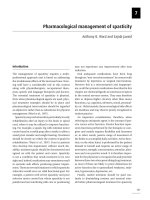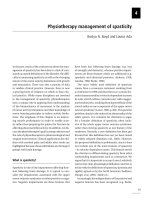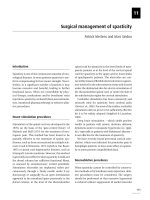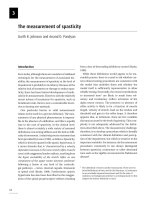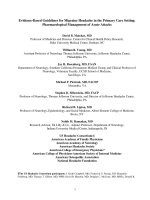Pharmacological management of spasticity
Bạn đang xem bản rút gọn của tài liệu. Xem và tải ngay bản đầy đủ của tài liệu tại đây (121.53 KB, 19 trang )
7
Pharmacological management of spasticity
Anthony B. Ward and Sajida Javaid
Introduction
The management of spasticity requires a multi-
professional approach and is based on addressing
the troublesome effects of the increased tone. Nurs-
ing staff have a considerable role in this context
along with physiotherapists, occupational thera-
pists, speech and language therapists and doctors.
The essential treatment of spasticity is physical.
Even when pharmacological agents are used, phys-
ical treatment strategies should be in place and
pharmacological interventions should be regarded
as adjunctive rather than as substitutes for physical
management (Ward et al., 1997).
Spasticitymay not be harmful, particularly in early
rehabilitation after an injury to the brain or spinal
cord, where it may be utilized to improve function-
ing. For example, a spastic leg with minimal motor
control may be a useful prop after a stroke to allow a
stand pivot transfer and weight bearing. Treatment
should be clearly set within the context of goals for
rehabilitation (Ward et al., 1997). Even in patients
who develop this impairment without much dis-
ability, treatment goals should be documented and
agreed on with the patient and carers. Spasticity
is not a condition that needs treatment in its own
right and, indeed, medication may sometimes result
in systemic side effects producing greater impair-
ment. There areseveral situations in which spasticity
reduction would serve no valid functional goal. For
example, a patient with severe spasticity and poor
selective motor control but whose spasticity is not
painful and not interfering with care or positioning
may not experience any improvement after tone
reduction.
Oral antispastic medications have been long
thought as “non-invasivetreatment” in contrast with
treatment by injections or surgical interventions.
However this is a misconception and inappropri-
ate, as all the systemic medications described in this
chapter are chemical ligands to numerous receptors
in the central nervous system. They may therefore
alter or depress higher circuitry other than motor
functions, e.g. cognition, alertness, mood, personal-
ity, etc. Unfortunately, these neurological side effects
are insidious and may thus be poorly recognized in
routine practice.
An important consideration, therefore, when
selecting an antispastic agent, is the concept of pas-
sive versus active function. Passive function repre-
sents functions performed by the therapist or care-
giver and mainly requires flexibility and looseness
or, in other words, passive range of movement of
the limbs to accomplish daily activities. Active func-
tion, on the other hand, is performed by the patient
himself or herself and requires an active range of
movement, strength, concentration,attention, alert-
ness and even positive mood. It is therefore impor-
tant for the physician to recognize this and prioritize
between these two whenprescribingdrug treatment,
as most of these are likely to prove deleterious for
active function due to generalized weakness, seda-
tion, hypotension, depression, etc.
Finally, careful attention should be paid rou-
tinely to diminishing noxious and external stim-
uli before pharmacological treatment for spasticity
131
132 Anthony B. Ward and Sajida Javaid
Table 7.1. Peripheral causes of aggravated muscle
over activity
External stimuli Internal stimuli
Tight clothing
Tight bandages, orthoses,
etc.
Kinked/blocked catheters
Condom drainage
appliances
Constipation, especially
colonic faecal loading
Infection and abscesses
Urinary retention and
infections
Pressure sores
Heterotopic ossification
Fractures/dislocations
is considered (Katz, 1988), as afferent stimulation
(e.g. flexor reflex afferents) rather than stretch recep-
tors may result in muscle over activity. These are
described in Table 7.1.
This chapter, therefore, discusses oral agents
and their place in overall management strategies.
Descriptions of other treatments may be found else-
where in this textbook.
Goals of treatment
It is essential to have a clear goal and expected out-
come prior to deciding the best course of treat-
ment. Oral medication should be started only if
generalized spasticity interferes with some level of
activity (e.g. positioning, care or comfort) and if
treatment is likely to ameliorate this interference
(see Table 7.2).
Management strategy
Spasticity treatment is worthwhile if there is impair-
ment of the patient’s function or the carer’s abil-
ity to care. Initially, treatment will be physical, as
already discussed, and thereafter will be indicated
through treatmentshown in the Table 7.2. Treatment
choices are usually quite straightforward, but occa-
sionally patient will seek treatment for their body
image and self-esteem rather than purelytheir physi-
Table 7.2. Goals of pharmacological treatment of
spasticity
Control of
symptoms
Reduction in pain and frequency of
spasm
Functional
improvement
Improvement in mobility and
dexterity, preservation of sexual
function, improvement in range of
joint movement and facilitation of
therapy and orthotic fit
Aesthetic Improvement in position of
limb/body
Carer’s burden Reduced burden of care with hygiene,
etc.
Prevention of
complications
Prevention of joint contractures and
hence delay of corrective surgery
cal functioning. Overtime,chronic spasticityleads to
rheological changes within the muscles, which lead,
in turn, to shortening and eventually contracture of
myocytes (Rack, 1966) and tendon shortening and
eventually limb deformity (Katz & Rymer, 1989). This
is seen most commonly in antigravity muscles and is
described in Chapter 2.
A management strategy is thus required. Pharma-
cological treatment may be initiated through oral
antispastic agents. By and large, baclofen is the
most commonly used agent, but is it really indi-
cated for spasticity of spinal origin (Pedersen et al.,
1974). Dantrolene sodium is regarded as more effec-
tive in cerebral spasticity, although its cognitive side
effects do limit its desirability in traumatic brain
injury (Monster, 1974). For patients with mild spas-
ticity, these drugs are quite effective, but success
becomes more limited as the spasticity worsens.
Because of the small therapeutic window between
clinical effect and toxicity, patients frequently find
that getting an effect from the drug involves intolera-
ble side effects. Clinicians must be therefore awareof
risk/benefit ratio when considering systemic agents.
Other treatments are available to complement these
traditional therapies (Penn et al., 1984; Das & Park,
1989), such as botulinum toxin for focal problems
of spasticity and nerve and neuromuscular junction
blockade with phenol and alcohol either alone or
Pharmacological management of spasticity 133
in combination with botulinum toxin (Liversedge,
1960). Neurosurgery is less commonly undertaken
in the UK and surgical techniques are mainly con-
fined to orthopaedic procedures like tendon length-
ening and soft tissue release. These are addressed
elsewhere in this volume.
Patient types
Spasticity should be actively treated when it is caus-
ing harm. Oral agents are generally given to peo-
ple with widespread spasticity rather than when it
is a localized problem. However, treatment is part of
the rehabilitation process and its aim should fit into
those of the overall rehabilitation objectives. Clear
goals must therefore be communicated tothepatient
in order to ensure the right expectations (Wade,
1988). Their side effects should be explained, par-
ticularly as they may cause drowsiness, and there
may thus be difficulties in patients with cognitive
deficits. This impairment is one of the main reasons
why their use has been limited in rehabilitation of
patients with severe disabilities. Generally speaking,
these drugs are introduced in small doses and the
dose increased to a point where there is an optimal
clinical effect. The dose should therefore be titrated
against the side effect. If the later is too troublesome,
then the drug should be stopped or reduced. In this
situation, combination treatment needs to be con-
sidered.
The goals for patients may differ depending on
their particular skills and the expected responses
to treatment may alter accordingly. The spasticity
management of someone with residual functioning
will be quite different to that of a nonfunctioning
patient (e.g. ambulation), whose cognitive abilities
may also be quite impaired. If the aim is to get the
patient to walk or to be dextrous, then a drug regi-
men that allows safety will be necessary, wheredrugs
to achieve a better posture in a wheelchair may have
different characteristics. Sometimes spasticity may
require treatment not for the disabled person but to
assist the carer. Reducing spasticity to allow perineal
hygiene, to ease dressing and to seat a patient com-
fortably in chair or wheelchair decreases the burden
on the carer, and this may be the primary treatment
aim (Young & Delwaide, 1981; Ward, 2002).
Combination treatment
Most oral antispastic agents can be used in combi-
nation with each other. The only reason for this is to
improve the clinical effect and lessen the incidence
of side effects, as it is ideally better to use one drug on
its own. Combinations of baclofen with dantrolene
sodium or benzodiazepines are probably the com-
monest, but these are more likely to affect higher
cerebral functioning. More importantly, though,
they can be used with newer treatments, such as
botulinum toxin, phenol and intrathecal baclofen.
Studies are under way to demonstrate this point.
Outcome measures
Wherever any treatment is used for spasticity, it is
important to measure the effect of the interven-
tion. Outcome measures have thus to be devel-
oped for easy use and to justify specific effect of
the antispastic treatment. This applies to all forms
of treatment, including physical therapy. These are
discussed in more detail elsewhere, but measures
should try to be as specific as possible in order to
identify the individual patient’s needs. They should
thus be tied in with the overall goals of treatment and
goal attainment should also be included. Because
antispastic agents are used for generalized spastic-
ity, there is a greater chance of seeing a change in
general physical functioning than with other more
focal agents. Sadly this is not usually the case,
but testing along the lines of the ICF can be helpful.
Examples of impairment testing include the motric-
ity index (Demeurisse et al., 1980) and stride length
(Ward, 1999), of activity timed walking test (Brad-
stater et al., 1983), the nine-hole peg test (Math-
iowetz et al., 1985) and of participation and quality
of life include the Nottingham Health Profile (Hunt
et al., 1980) and Short Form 36 Questionnaire (Ware,
1993). Many of these testsarequitesensitive for func-
tion in patients with progressive disability, such as
multiple sclerosis, where they give an indication not
134 Anthony B. Ward and Sajida Javaid
Table 7.3. Tone intensity scale
Name Description Reference
Modified Ashworth Ordinal scale of tone intensity 0–5 Bohannon & Smith, 1986
Oswestry scale of grading Ordinal scale of stage and distribution of tone
and quality of isolated movements
Goff, 1976
Degree of adductor muscle tone Ordinal rating of hip adductors Snow, 1990
Table 7.4. Spasm frequency scale
Name Description Reference
Pen spasm frequency score Ordinal scale of frequency of leg spasm per hour Penn, 1989
Spasm frequency score Ordinal ranking of spasm frequency per day Snow, 1990
Table 7.5. Activities of daily living/hygiene scale
Name Description Reference
Barthel ADL index Subset of Barthel index Mahoney & Barthel, 1965
Table 7.6. Upper extremity dexterity and strength testing
Name Description Reference
Grasp dynamometer testing Objective instrument to measure grasp in pounds Trombly & Scottad, 1977
The nine-hole peg test Simple and time-efficient measure of finger dexterity Kellor & Frost, 1971
Table 7.7. Clinical gait scores
Name Description Reference
Timed ambulation Temporal distance gait measure Holden & Gill, 1984
Ambulation index Ordinal scale of ambulation distance, speed and level of
assistance needed
Hauser, Dawson, Lehrich,
Beal, & Kevy, 1983
Functional ambulation
classification
Nominal scale of ambulation dependence/independence
grading amount of assistance needed
Holden & Gill, 1984
only of the patient’s ability to ambulate but also of
his or her well-being. No one scale is superior as a
measure of every aspect of spasticity and resultant
functional change associated with the use of anti-
spasticagents.As a result,theplannedoutcomemea-
sures must be selected with a specific purpose in
mind. While the use of only one scale may be jus-
tified in some clinical situations, more meaningful
results will almost always be obtained by using sev-
eral different well-chosen scales; some of them are
discussed briefly below (Tables 7.3 to 7.11). See also
Chapter 3.
Pharmacological management of spasticity 135
Table 7.8. Goniometry
Name Description Reference
The clinical measure of joint motion Instrumental measure of range of movement Greene & Heckman, 1994
Table 7.9. Pain assessment scale
Name Description Reference
Visual analogue
scale
Patient self-rating of pain intensity on 10-point scale
ranging from no pain to extremely intense pain
Gracey & McGrath, 1978
Brace-wear measure Ordinal scale of orthotic fit Pierson & Kartz, 1996
Table 7.10. Global scales of disability
Name Description Reference
Functional independence
measure (FIM)
Ordinal scale of function in multiple areas including feeding,
grooming, bathing, dressing, toileting, transfers, locomotion,
comprehension, expression, social interaction and problem
solving
Buffalo, New York, 1993
Table 7.11. Patient/caregiver assessment/quality of life measures
Name Description Reference
SF-36 health survey 36-Item patient report regarding patient’s perception of
health and physical limitations, subscores are weighted
in an interval style
SF-36 health survey, 1992
Caregiver dependency
scale
Patients report regarding the amount of caregiver
assistance required on a typical day
Environmental status scale,
National MS Society, 1985
Northwick Park care
dependency scale
To assess dependency of patients in a rehabilitation setting
in terms of impact on nursing staff time
Turner-Stokes et al., 1990
Specific treatments
Oral antispastic agents are usually indicated in
patients with diffuse or regional muscle spasticity
rather than localized muscle spasticity. Despite the
large number of drugs that have been reported to
influence muscle tone, very few have been found
useful in clinical practice. The commonly used anti-
spastic drugs arebaclofen, benzodiazepines,dantro-
lene sodium and tizanidine. The drugs can be used
alone as monotherapy or in combination to reduce
the spasticity effectively. Cannabis has been widely
discussed, but there is no evidence that it has a sus-
tained effect as an antispastic drug (CAMS Study).
Baclofen
Baclofen is a structural analogue of gamma-
aminobutyric acid (GABA), which is one of the main
inhibitory neurotransmitters in the central nervous
136 Anthony B. Ward and Sajida Javaid
Table 7.12. Efficacy of antispastic agents in specific patient population
Antispasticity
medication MS SCI Stroke TBI CP Side effects
Dantrolene ++++ +Muscle weakness, hepatotoxicity
Baclofen(oral) ++ + +/− Sedation, difficult seizure control
Tizanidine ++ + + Dryness of mouth, liver dysfunction
Diazepam +++/−+Sedation
Clonazepam +? Sedation
+ The antispastic efficacy and tolerance have been established in a double-blind study.
++ The antispastic efficacy and tolerance of the drug have been demonstrated to be greater than the one of the
standard drugs in double-blind comparative studies.
+/− The overall improvement was mitigated in the double-blind trials mainly because of intolerable side effects.
+? Open-label trials have been promising but no double-blind studies have been conducted.
An empty box means that the drug has not been investigated to our knowledge in the condition indicated.
MS=multiple sclerosis; SCI=spinal cord injury; TBI=traumatic brain injury; CP=cerebral palsy.
system. Chemically, baclofen has the structure of
beta-chlorphenyl-gamma-aminobutyric acid and is
available as an approved drug in its racemic mixture
with about equal content of the two enantomeres
D-baclofen and L-baclofen. Laboratory studies have
shown that L-baclofenis the activeenantiomer(Olpe
et al., 1978; Johnston et al., 1980) and D-baclofen
antagonizes the action of L-baclofen (Sawynok &
Dickson, 1985; Fromm & Terrence, 1987).
Mechanism of action
Baclofen binds to the bicuculline-insensitive GABA-
B receptors (Price et al., 1984; Hwang&Wilcox,1989),
which are primarily located presynaptically at the
Ia sensory afferent neurones or the interneurones
(Price et al., 1987) and some are also located post-
synaptically at the motor neurones (Wang & Dun,
1990). Upon binding the GABA-B receptor sites,
the calcium influx through high-voltage–activated
channels in the membrane of group Ia presynap-
tic terminals is inhibited and the release of endoge-
nous excitatory neurotransmitters such as gluta-
mate and aspartate are suppressed (Hill & Bow-
ery, 1981; Davidoff, 1991; Curtis et al., 1997). The
postsynaptic GABA-B receptor–mediated inhibition
is likely to occur by activating potassium chan-
nels through a membrane-delimited pathway and
also through a second-messenger pathway involving
arachidonic acid (Misgeld et al., 1995). It also inhi-
bits gamma motor neurone activity and reduces
intrafusal spindle muscle sensitivity. The net result
in inhibition of bothmonosynapticand polysynaptic
reflexes. In addition, animal studies have suggested
that baclofen alsohas anti-nociceptive and analgesic
properties, possibly by reducing the release of sub-
stance P from nociceptive afferent nerve terminals
(Henry, 1980).
Pharmacokinetics
Baclofen can be administered both by mouth and
by intrathecal injection. After oral administration, it
is rapidly and completely absorbed from the gastro-
intestinal tract, with peak plasma levels occurring 1
to 2 hours after administration. Its plasma half-life is
approximately 3.5 hours (range 2 to 6.8 hours). The
serum protein-binding rate is approximately 30%,
and 70% to 80% of baclofen is excreted unchanged
through the kidneys within 72 hours. A small propor-
tion (about 10%) is metabolized in the liver (Faigle
& Keberle, 1992). It can cross the placenta, and
only a small amount crosses the blood–brain barrier
(Pedersen et al., 1974).
Clinical efficacy
Baclofen has been used as an antispastic drug for
over 30 years. The majority of clinical trials in several
Pharmacological management of spasticity 137
countries generally involve patients with multiple
sclerosis and spinal cord lesions and have proven
that baclofen is effective in reducing spasticity and
sudden painful flexor spasms (Pinto et al., 1972;
Duncan et al., 1976; Feldman et al., 1978). However,
most of the studies fail to demonstrate improve-
ment of mobility and activities of daily living(From&
Heltberg, 1975).
In a double-blind crossover trial of baclofen and
placebo in 23 patients (18 with multiple sclero-
sis and 5 with spinal cord lesions), Hudgson and
Weihtman (1971) reported a reduction in spasticity
and baclofen was well tolerated. In 1976, Duncan
et al. (1976) performed a double-blind, crossover
study on 22 patients with spinal cord lesions and
found that baclofen was significantly effective in
reducing spasticity and reflex spasms of the legs and
urinary bladder and was well tolerated. The larger
multicentre, double-blind, placebo-controlled trial
in 106 patients with spasticity secondary to multi-
ple sclerosis also confirmed that baclofen was effec-
tive in relieving symptoms of spasticity such as flexor
spasms, clonus, pain, stiffness, resistance to pas-
sive movement of joints and tendon stretch reflex
(Sachais et al., 1977).
In three comparative studies (Ketlaer & Kneeler,
1972; Cartlidge et al., 1974; From & Heltberg, 1975),
baclofen was found to be significantly more effec-
tive than diazepam in reducing spasticity secondary
to multiple sclerosis, with considerably less day-
time sedation. In a double crossover study (Rous-
san et al., 1987) of baclofen versus diazepam in 13
patients (7 with multiple sclerosis and 6 with spinal
cord injury), both drugs produced similar improve-
ment of spasticity, but side effects, especially exces-
sive daytime sedation, were more common in those
treated with diazepam. This study again showed the
long-term efficacy and safety of baclofen therapy
without evidence of drug tolerance, even after many
years.
There have been few studies investigating the
effect of baclofen in treatment of spasticity of cere-
bral origin, and the results described suggest a more
limited benefit that achieved among patients with
multiple sclerosis and spinal cord lesions (Whyte &
Robinson, 1990).
Dosage and administration
The recommended oral dosage ranges from 40 to
100 mg daily. In adults, the dosage begins with 5 mg
orally two to three times daily and is gradually
titrated to achieve an optimal clinical response with
minimal side effects. If the dosage is too high or
has been increased too rapidly, side effects may
occur, especially in patients who are immobile
or elderly. Although the manufacturer’s maximum
recommended oral dosage is 100 mg daily, many
patients with multiple sclerosis have received higher
doses, which were found to be well tolerated (Pinto
et al., 1972; Smith et al., 1991). If the therapeutic
effects are not evident in 6 weeks, it may not ben-
efit the patient to continue with the therapy.
Elderly patients are more susceptible to side
effects and small initial dose increments under care-
ful supervision are advised. In children, dosages in
the range of 0. 75 to 2.5 mg/kg body weight should be
used, and the treatment usually initiates with 2.5 mg
four times daily, with gradual increments at approx-
imately 3-day intervals until a therapeutic response
is achieved.
Side effects
There is low incidence of side effects, and these usu-
ally occur upon initial treatment with large doses or
in the treatment of patients with spasticity of cere-
bral origin and of the elderly (Aisen et al., 1993).
These adverse effects rarely require withdrawal of
medication and are frequently mild and transient.
Modifying the dosage may lessen or eliminate the
side effects. Sometimes it may be difficult to dis-
tinguish between drug-induced undesirable effects
and those caused by the underlying diseases being
treated.
Mild gastrointestinal disturbances such as a dry
mouth, nausea, vomiting, constipation or diar-
rhoea have been reported. Drowsiness and day-
time sedation may occur especially at the initi-
ation of treatment. Other reported neurological
effects are lassitude, exhaustion, lightheadedness,
ataxia, confusion, dizziness, headache, insomnia,
myalgia,muscle weakness,euphoria, hallucinations,

